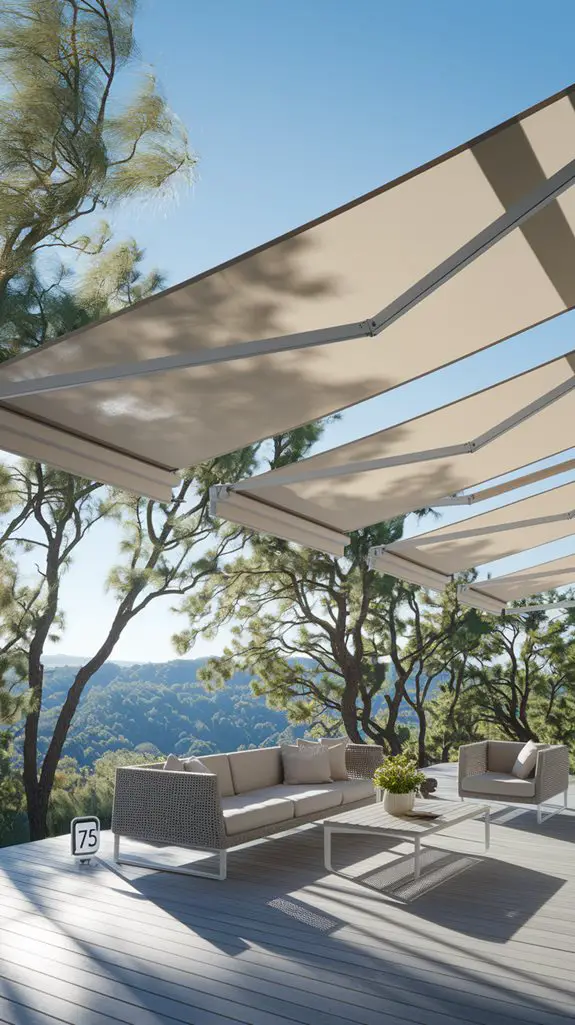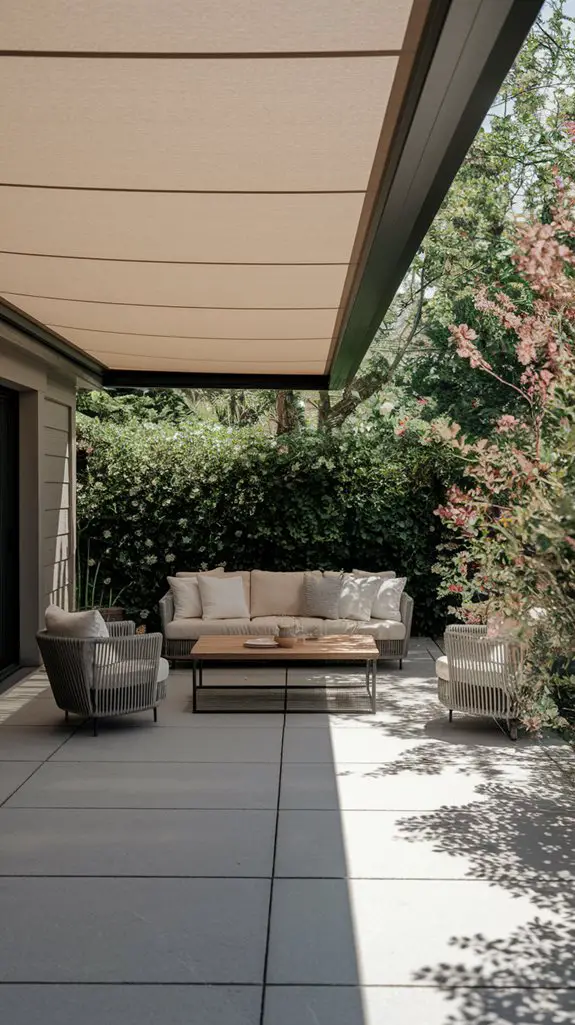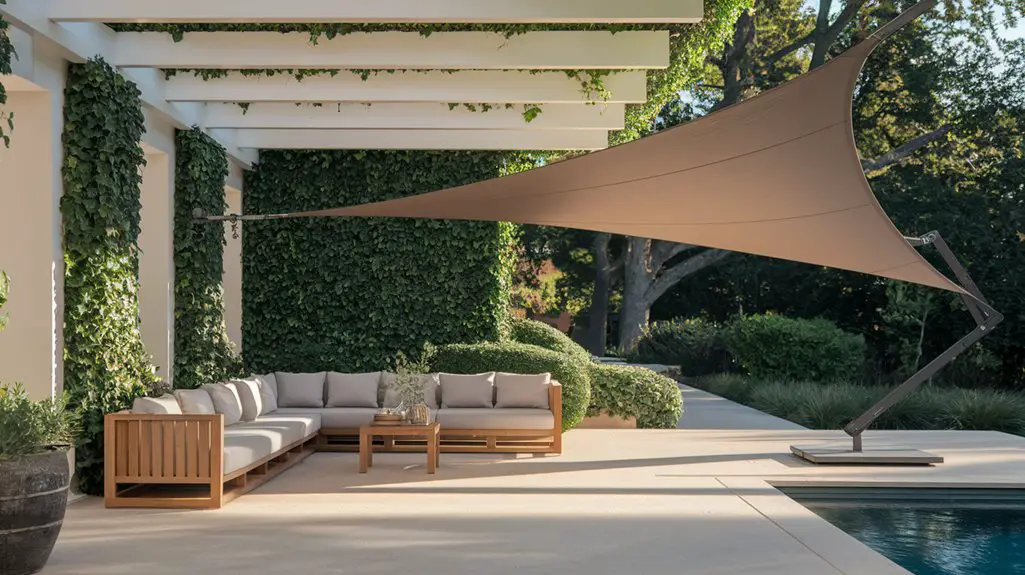Most homeowners underestimate the impact of seasonal sun angle variations when selecting patio shade solutions, potentially leaving their outdoor spaces unusable during peak summer months. You’ll need to contemplate not just current conditions, but how shadows shift across your property throughout the day and year. The right shade system transforms your patio from an occasional retreat into a functional extension of your living space, while the wrong choice can result in wasted investment and continued discomfort. What factors should guide your decision?
Assess Your Patio’s Sun Exposure Pattern
When selecting the ideal shade solution for your patio, understanding your space’s unique sun exposure pattern serves as the critical first step.
Track the sun’s movement across your patio throughout the day and across seasons to identify high-exposure periods that require mitigation.
Note the angles at which sunlight strikes your space during peak usage hours. Morning eastern exposure differs greatly from intense afternoon western sun.
Use a sun tracking app or simply mark hourly sun positions for several days to create an exposure map.
Consider seasonal variations—summer sun sits higher and creates different shadow patterns than winter sun. This analysis will determine whether you need permanent structures like pergolas, adjustable options such as retractable awnings, or strategic placement of umbrellas that can address specific hot spots.
In addition, understanding the benefits of permanent shade structures can help you make a more informed decision.
Consider Climate and Weather Conditions

Beyond sun patterns, your local climate dictates which shade solutions will prove both effective and durable for your outdoor space. Wind resistance becomes critical in gusty regions, where retractable awnings might fail while pergolas with reinforced footings endure.
Precipitation considerations affect material selection—canvas deteriorates quickly in humid environments, while powder-coated aluminum resists rust in coastal areas.
- Temperature extremes: Select heat-resistant fabrics in hot climates; choose materials that won’t become brittle in freezing conditions.
- Seasonal variations: Consider retractable options for changing weather patterns throughout the year.
- Environmental factors: Account for salt exposure near oceans, UV degradation in high-altitude locations, and snow load capacity in northern regions.
Your shade solution’s longevity depends on matching materials and structural designs to your specific microclimate challenges. Additionally, investing in durable shade solutions can significantly enhance the lifespan of your outdoor patio setup.
Evaluate Fixed vs. Retractable Shade Options

Weather adaptability influences one of the most significant decisions in patio shade planning: whether to install fixed or retractable solutions. You’ll need to weigh permanence against flexibility, considering your specific usage patterns and local climate variables.
| Feature | Fixed Shades | Retractable Shades |
|---|---|---|
| Initial Cost | Lower investment | Higher upfront expense |
| Durability | Typically more robust | Mechanical components may fail |
| Seasonal Versatility | Limited adaptability | On-demand adjustment |
| Maintenance | Minimal requirements | Regular system servicing |
| Wind Resistance | Higher tolerance | Must retract during high winds |
Fixed structures offer stability and permanent protection but lack adaptability when sun angles shift seasonally. Retractable options provide customized light control but require more complex installation and maintenance protocols. Your choice should align with both your immediate comfort needs and long-term property investment strategy. Additionally, incorporating natural shade solutions can enhance your outdoor experience while providing environmental benefits.
Match Shade Solutions to Your Patio’s Size and Shape
Every patio configuration demands a tailored shade solution that maximizes coverage while maintaining visual proportions.
For rectangular spaces, consider sail shades or retractable awnings that can span the length while preserving sightlines.
Circular patios benefit from centrally-mounted umbrella systems or pavilion structures that echo the rounded footprint.
When selecting your shade solution, analyze:
- Square footage ratio – ideal shade coverage should protect 60-80% of your usable patio space
- Overhead clearance requirements – account for minimum 7′ headroom plus any additional height needed for heat dispersion
- Mounting points availability – structural support locations will determine feasible installation options for canopies or pergolas
Don’t overlook the importance of scale matching – oversized shade structures overwhelm intimate spaces, while undersized options fail to provide adequate protection for larger entertaining areas. Additionally, affordable patio shade ideas can enhance the functionality of even the smallest backyards.
Balance Aesthetics With Functionality
While achieving complete sun protection remains the primary goal, your shade solution should also complement your home’s architectural style and outdoor design scheme.
Select materials and designs that harmonize with existing elements—modern homes pair well with sleek metal pergolas or minimalist shade sails, while traditional architecture benefits from wooden structures or classic awnings.
Consider color compatibility with your home’s exterior and existing outdoor furniture. Opt for weather-resistant fabrics in UV-stable dyes that won’t fade prematurely.
Seek solutions that offer customization options for hardware finishes and fabric patterns.
Remember that functionality extends beyond mere shade—proper ventilation prevents heat buildup, retractable options provide flexibility, and integrated features like lighting or misting systems enhance usability. Utilizing eco-friendly patio shading options can also contribute to a sustainable outdoor environment.
The ideal solution strikes a balance between visual appeal and practical performance, creating an outdoor space that’s both beautiful and comfortable.
Compare Material Durability and Maintenance Requirements
When selecting patio shade solutions, you’ll need to carefully evaluate the durability and maintenance requirements of different materials, as these factors directly impact long-term satisfaction and ownership costs. Different materials offer varying lifespans and require specific care regimens based on your local climate conditions.
Consider these critical material comparisons:
- Fabric coverings (canvas, acrylic, polyester) require periodic cleaning and may need replacement every 3-5 years, while metal structures (aluminum, steel) offer decades of use with minimal maintenance.
- Wood pergolas provide natural aesthetics but demand annual treatments against moisture and insects.
- Vinyl and fiberglass options deliver excellent weatherproofing with simple cleaning requirements but may deteriorate under extreme UV exposure.
Additionally, investing in stylish shade solutions can enhance both functionality and aesthetics of your outdoor space. Assess your willingness to perform regular maintenance against your budget for higher-quality, lower-maintenance materials.
Factor in Budget Constraints and Long-Term Value
Understanding budget constraints remains essential when selecting patio shade solutions, as initial costs can vary dramatically from under $100 for basic umbrellas to several thousand dollars for permanent structures.
When evaluating options, calculate the total cost of ownership including installation, maintenance, and potential replacements over time.
Higher-priced items like retractable awnings and pergolas typically offer superior longevity and functionality, often proving more economical across a 5-10 year horizon.
You’ll maximize value by selecting materials and designs that align with your climate conditions and usage patterns.
For limited budgets, consider phased implementation—start with a quality umbrella, then upgrade to permanent structures when finances allow.
Remember that certain shade solutions, particularly architectural options, can increase property value, effectively recouping a portion of your investment should you sell your home. Additionally, investing in luxurious shade options can enhance your outdoor experience and elevate the overall aesthetic of your patio.
Incorporate Lighting and Heating Elements
Beyond budgetary considerations, a thorough patio shade solution integrates lighting and heating elements that extend your outdoor living hours and seasons.
When selecting these components, you’ll need to evaluate power sources, weatherproofing requirements, and aesthetic cohesion with your shade structure.
- Lighting options – Consider recessed LEDs for pergolas, string lights for fabric canopies, or solar-powered accent lighting for umbrella edges that provide ambient illumination without additional wiring.
- Heating elements – Integrate infrared panels into permanent structures, portable propane heaters for temporary setups, or tabletop fire features that complement retractable awnings.
- Control systems – Invest in weather-resistant smart controls that allow programming of both lighting and heating elements according to usage patterns and weather conditions.
Additionally, incorporating outdoor lighting options can enhance safety and ambiance, ensuring that your entertainment zones are inviting after dusk.
You’ll maximize your outdoor space’s functionality by thoughtfully incorporating these dual-purpose elements.
Explore Eco-Friendly and Sustainable Shade Alternatives
As environmental consciousness grows among homeowners, sustainable patio shade solutions offer compelling alternatives to conventional options.
Consider bamboo pergolas or shade structures, which utilize rapidly renewable resources while providing excellent overhead protection. Reclaimed wood trellises create distinctive shade patterns and repurpose materials that would otherwise end up in landfills.
Living shade options like climbing vines on cable systems or strategically planted trees offer carbon-capturing benefits while naturally cooling your outdoor space through evapotranspiration. Additionally, incorporating renewable resources into your landscaping can enhance the ecological benefits of your outdoor area.
Solar-powered retractable awnings and canopies eliminate the need for electrical wiring while harnessing renewable energy.
When selecting fabrics for shade sails or curtains, look for recycled polyester or organic cotton blends certified by organizations like Global Organic Textile Standard (GOTS) that guarantee sustainable manufacturing processes and biodegradable materials.
Conclusion
You’ll see the greatest return on your shade investment by taking time to evaluate sun patterns, materials, and long-term functionality. Studies show properly shaded patios can reduce ambient temperatures by up to 20°F, greatly enhancing comfort while reducing cooling costs. Assess both immediate needs and future adaptability to select solutions that will evolve with your outdoor lifestyle and provide sustainable protection for years to come.




